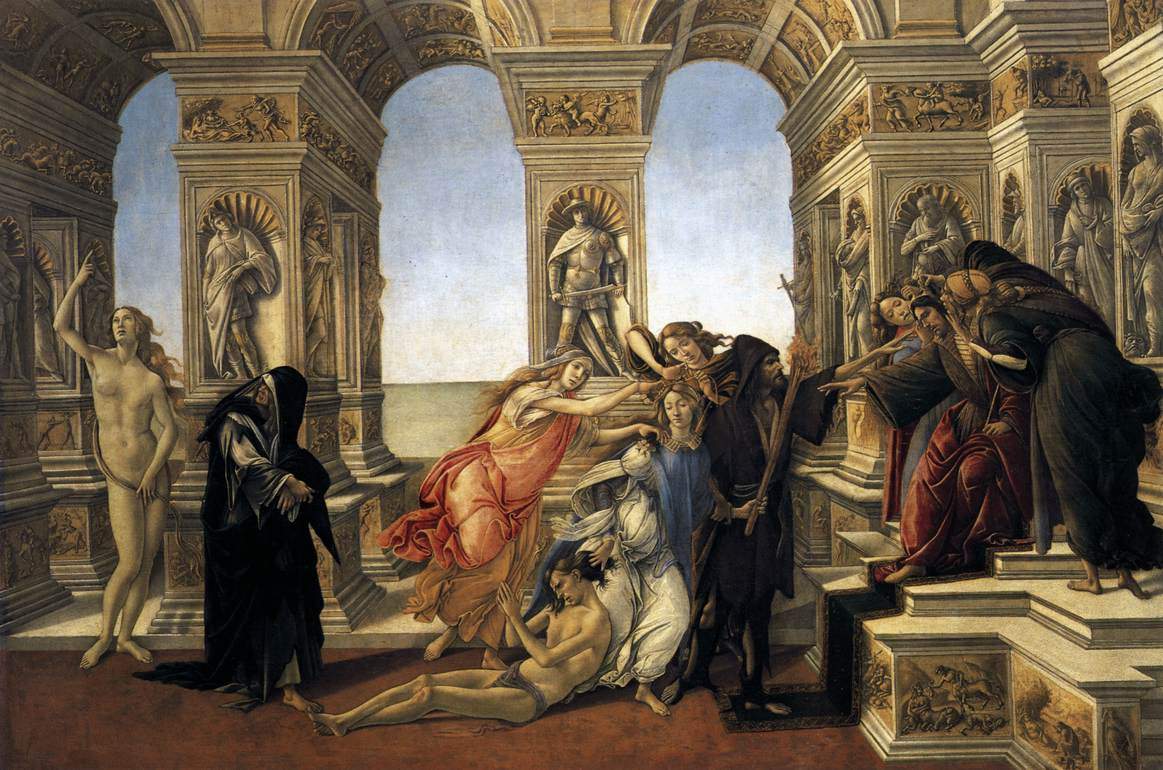New study on Botticelli's Calumny brings out interesting facts about the masterpiece
New discoveries around one of Sandro Botticelli’s most famous paintings, namely Apelles’ Calumny. In particular, it seems that among the sources that inspired the great Florentine Renaissance artist were also Ovid, Dante, Boccaccio, and thus the Metamorphoses, the Divine Comedy, and the Decameron. This is the main novelty that emerges from the book Sandro Botticelli’s La Calunnia. Politics, Vices and Civil Virtues in Renaissance Florence (Officina Libraria, pp.294), just published and presented today at the Uffizi Gallery, edited by Monica Centanni (full professor of Greek Literature) and Sara Agnoletto (Ph.D. in History of the Arts), both from the University Institute of Architecture of Venice (Iuav).
The study reveals for the first time the meanings hidden in the most enigmatic of the paintings made by the great Florentine artist through literary references, particularly Ovid, Dante Alighieri and Boccaccio. In fact, the volume recounts the painting exhibited at the Uffizi, flanking the text with a photographic campaign conducted specifically for the publication. The authors investigate the problem of its dating in a new light and analyze the work from unexplored points of view, revealing symbologies that have remained hidden until now.
On the iconography of Calumny many scholars have confronted each other, with different proposals for interpretation. The panel, centered on concepts such as defamation and injustice, was created from Lucian of Samosata’s literary description of a famous painting by Apelles, which may never have existed; the distance between text and image, coupled with Botticelli’s necessary reworking of the subject, has always made interpretation of the painting extremely difficult. Now, thanks to the identification of new textual sources, Monica Centanni and Sara Agnoletto promise to decipher the scenes contained in the painting for the first time.
And it would have been Dante’s Divine Comedy, in addition to dictating the appearance of one of the characters in the foreground,Envy, that inspired some of the architectural spaces of the loggia, such as the one depicting the flagellation of ruffians and seducers, an obvious reference to Malebolge. Ovid ’s Metamorphoses, on the other hand, are echoed in the reliefs of Apollo and Daphne, Atamanthus and the Judgment of Paris, while of Boccaccio-like ascendancy is the panel dedicated to Cimon and Iphigenia. And again, other sculptures bear the influence of Pliny, Livy, and theOld Testament: the loggia is entirely populated by literary visions.
The identification of all the images contained in the solemn architecture that frames the main scene has allowed scholars to classify La Calunnia as a true “combat” between the vices and virtues of the time, in the oppressive climate that followed Savonarola’s death. Indeed, the painting must have played, in the author’s mind, the civil role of a guide to the management of power: through a sharp and precise analysis, the authors have identified Lorenzo di Pierfrancesco de’ Medici, a driving figure in Florentine politics at the time, as the recipient of these important lessons. Making itself a manual of what was considered good and evil in the Renaissance, Calumny thus also becomes a condensation of the culture and ideals of the time, a visual encyclopedia of the feeling of those years.
Between a masterpiece such as the Birth of Venus and the small painting of Calumny there is, after all, an irrefutable connection: in fact here,
among the figures in the foreground stands out the Nuda Veritas, the embodiment of the humanistic ideals of truth and honesty, never mentioned in the text of Lucian of Samosata and therefore a totally Botticellian idea. The woman, shyly covering her pubis while raising her other arm toward the sky, seems to be a miniature of the Venus of the Uffizi. La Calunnia is in fact laden with Botticellian self-quotations, which research by the book’s authors has made it possible to identify for the first time. Another novelty thus emerges from the volume , which in fact illustrates how most of the subjects depicted in the loggia reliefs are in fact small-scale reproductions of autonomous works by the Florentine artist: some of the paintings evoked are, for example, the Return of Judith to Betulia and the Judgement of Paris, also housed in the Uffizi Galleries, or Nastagio and the Hell Hunting in the Classe Pine Forest (Prado, Madrid), another reference to Boccaccio’s Decameron. On the other hand, the very ambition to represent and thus connect to a painting by Apelles, the great Greek painter of Classicism, demonstrates the possibility that Botticelli made his Calumny a manifesto of self-assertion: just as Ovid had inserted himself in the footsteps of the great Greek poet of the symposium, proclaiming himself “Roman Alceus,” Botticelli could have elected himself, in the wake of Apelles, “master of the classical manner,” and thus, “luminary of the Renaissance.”
"Sandro Botticelli’s Calumny. Politics, Vices and Civil Virtues in Renaissance Florence," comments Uffizi Galleries Director Eike Schmidt, "represents a breakthrough in the understanding of the great Florentine painter’s mysterious painting. Thanks to new, convincing hypotheses about the dating, the identification of specific literary and pictorial sources, and a parade of images that bring into focus the painting’s particularities, Sara Agnoletto and Monica Centanni’s study allows readers to fully grasp the meaning of La Calunnia, and to fully enjoy, for the first time, its thematic and visual complexity."
Image: Sandro Botticelli, The Calumny of Apelles (1494-1495; tempera on panel, 62 x 91 cm; Florence, Uffizi Galleries)
 |
| New study on Botticelli's Calumny brings out interesting facts about the masterpiece |
Warning: the translation into English of the original Italian article was created using automatic tools. We undertake to review all articles, but we do not guarantee the total absence of inaccuracies in the translation due to the program. You can find the original by clicking on the ITA button. If you find any mistake,please contact us.





























